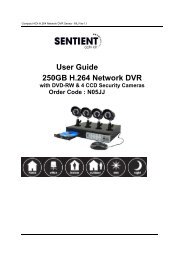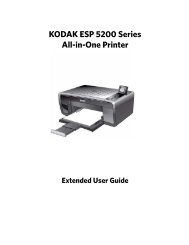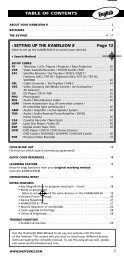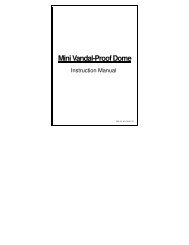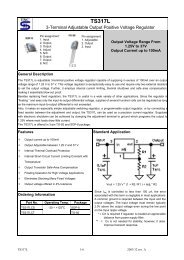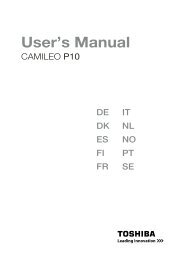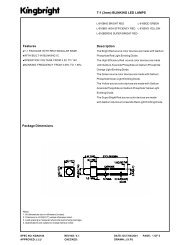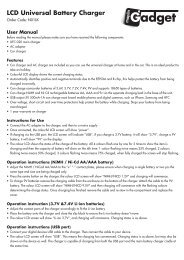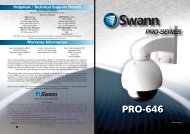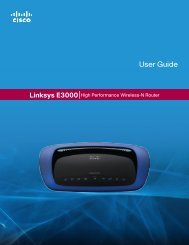Computer Anatomy - Maplin Electronics
Computer Anatomy - Maplin Electronics
Computer Anatomy - Maplin Electronics
You also want an ePaper? Increase the reach of your titles
YUMPU automatically turns print PDFs into web optimized ePapers that Google loves.
Sound card - Together with the speakers, a sound card determines<br />
a computer’s ability to reproduce sound for watching DVD movies,<br />
listening to music and realistic game sound effects. Most computers<br />
come with a built-in sound card, a separate sound card that can be<br />
fitted into a computer’s expansion slot offers better sound quality<br />
and added features for recording and creating digital music and<br />
sounds.<br />
TV Cards - A TV tuner allows you to watch free-to-view<br />
analogue/digital (depending on the PC) television on your computer.<br />
It also allows you to record television on to your hard disk.<br />
Operating systems (O/S)<br />
Windows - Windows XP Media Center provides the advanced<br />
computing power of Windows XP Home and also allows you to<br />
watch DVDs, record TV (if the PC has a TV tuner), listen to music,<br />
share your digital photos and more; all through simple, easy to use<br />
menus. The new Vista range represents the next generation and a<br />
different style of Windows operating system.<br />
Linux - A similar O/S to Windows, based on a graphical user<br />
interface. The major difference is that Linux is largely free to<br />
download over the internet. You may have to pay for support<br />
services.<br />
PCI expansion slots<br />
PCI - (Peripheral Component Interconnect) expansion slots allow<br />
your computer to be compatible with future technology or<br />
additional hardware such as memory. Most computers now have<br />
several PCI slots allowing you to easily upgrade your computer.<br />
PCI-X! - Not used for graphics but uses up less space and power<br />
than the normal PCI. Used for modems, TV Cards and soundcards.<br />
USB Connections - Universal Serial Bus connections allow you to<br />
‘Plug ‘n’ Play’ peripherals, such as a printer without needing to shut<br />
down the computer. The more USBs, the better: USB 2.0 is much<br />
faster than USB 1.0 at speeds up to 480MB/s.<br />
PC Case<br />
ATX – Standard form factor for putting a motherboard in.<br />
Micro ATX – Smaller than ATX. You may need to buy a micro ATX<br />
motherboard to fit.<br />
What does that mean?<br />
AGP – Advanced Graphics Port<br />
ATX - Advanced Technology eXtended<br />
BIOS - Basic Input / Output System<br />
Clock speeds – Number of clock cycles –<br />
the speed of processing of your chip<br />
CPU – Central Processing Unit<br />
DDR – Double Data Rate<br />
DVI - Digital Visual Interface<br />
FDD – Floppy Disc Drive<br />
HDD - Hard Disk Drive<br />
Heatsink Fans – Cools the chip. A good fan cools better and<br />
increases the chip’s performance<br />
Modder – Someone who ‘styles’ their PC<br />
Overclocking – Increasing the voltage to get more processing power.<br />
Shortens the life of your PC<br />
PSU – Power Supply Unit<br />
PATA - Parallel Advanced Technology Attachment<br />
PCI - Peripheral Component Interconnect<br />
PCI-E - PCI Express was formerly known as Arapaho or<br />
3GIO for 3rd Generation I/O<br />
RAM - Random Access Memory<br />
SATA - Serial Advanced Technology Attachment<br />
SLI - Scalable Link Interface<br />
VGA - Video Graphics Array<br />
More information<br />
Make sure you ask one our members of staff to<br />
ensure you buy the right product or visit<br />
www.maplin.co.uk/howto.asp<br />
<strong>Maplin</strong> <strong>Electronics</strong> Ltd<br />
Valley Road, Wombwell, Barnsley,<br />
South Yorkshire, S73 0BS<br />
Your guide to the<br />
Components that<br />
make up a PC
What makes up a PC?<br />
Processors<br />
The processor is one of the major components that determine a<br />
computer’s performance.<br />
What difference do the different processor speeds make?<br />
The speed is measured in Gigahertz (GHz). Generally the better the<br />
processor, the faster your computer will run: an Athlon 3200 will not<br />
have the same power as a Athlon 3500. This is the speed of the<br />
computer brain.<br />
What are the advantages of dual-core processors?<br />
A dual-core CPU combines two independent processors and their<br />
respective caches and cache controllers on to a single silicon chip<br />
or integrated circuit allowing you to run more applications<br />
simultaneously compared to a single core processor.<br />
What is MHz FSB for processors?<br />
The units used to measure the frequency of electric vibrations per<br />
second, typically this is used as a measure of a processor’s Front<br />
Side Bus (FSB). Eg. 533MHz FSB. In computers, the front side bus or<br />
system bus is the physical bi-directional data bus that carries all<br />
electronic signal information between the central processing unit<br />
(CPU) and other devices within the system such as Random Access<br />
Memory (RAM), AGP video cards, PCI expansion cards, hard disks,<br />
the memory containing the system BIOS etc.<br />
What is a cache?<br />
Cache is a computer's short-term memory and is measured in<br />
Kilobytes (kB) and Megabytes (MB). Recently modified documents<br />
are stored in the computer system’s cache allowing you to access<br />
them quicker. The more cache in a computer’s processor, the better<br />
the computer will perform.<br />
Motherboards<br />
The motherboard of a computer is the primary circuit board where<br />
all the internal components of a computer are connected.<br />
Memory<br />
Memory is measured in Megabytes (MB) and Gigabytes (GB).<br />
The more memory you have in your computer, the quicker the<br />
processing of documents, downloads and programs.<br />
RAM<br />
RAM (Random Access Memory) is where the computer system<br />
stores software applications and data that are being used. DDR or<br />
Double Data Rate effectively almost doubles the stated data<br />
transmission rate. Like DDR, DDR2 is a form of RAM. DDR2 is the<br />
next evolutionary step in the DDR infrastructure.<br />
Power supplies units (PSUs)<br />
You need to ensure your power supply can provide enough power<br />
for your PC, so as general rule; the more wattage, the better. If you<br />
want to run dual graphics cards, you will need two graphics power<br />
connectors that most PSUs don’t have; certainly on the lower<br />
wattages. Modern PSUs have a huge amount of connectors, so to<br />
help you out, we’ve compiled this handy guide to steer you through<br />
the power cable minefield:<br />
4-Pin ATX 12V - This small connector is usually located next to the<br />
Central Processing Unit socket and provides the CPU with an extra<br />
dose of current at 12V.<br />
8-Pin EPS 12V - Not surprisingly, dual-core CPU and dual-CPU<br />
motherboards require twice as much power as single-processor<br />
designs. This connector is essentially two 4-pin ATX 12V connectors<br />
linked together.<br />
24-Pin ATX - Modern motherboards consume more power than their<br />
predecessors, so the 24-pin ATX connector replaced the 20-pin.<br />
Molex - The ‘handyman’ of PSU connectors, used to provide power<br />
to everything from hard disks to graphics cards. If your PSU doesn’t<br />
have enough Molex connectors, it won’t perform.<br />
PCI-E - This 6-pin connector was recently introduced to provide<br />
extra power for graphics cards. If you want to build an SLI PC then<br />
make sure your PSU has two PCI-E connectors.<br />
S-ATA – This is not the strongest of connectors. It powers S-ATA and<br />
S-ATA II hard disks and optical drives.<br />
Hard Drive - The hard drive (hard disk) of a computer provides you<br />
with space to store your programs and personal files and is<br />
measured in Gigabytes (GB). Although the size of hard drives in<br />
today’s computers are generally larger than you will ever require;<br />
you can never be too sure, so the larger the better. A gigabyte (GB)<br />
is a data storage capacity measure that equals approximately<br />
1000MB or 1 billion bytes.<br />
Optical Drive - Most disk drives available today have the ability to<br />
read and write DVDs (Digital Versatile Discs) and provide a far<br />
greater storage capacity (around 5GB compared to 700MB on a CD).<br />
This in turn means that you can store more multimedia files such as<br />
films, music and photos on one single disc.<br />
Graphics Card - Graphics cards are responsible for the quality of<br />
images displayed on your monitor. A good graphics card is needed<br />
for graphics intensive tasks such as computer gaming.<br />
There are five types of card:<br />
PCI - allows you to upgrade your computer quickly and easily.<br />
Mainly used for adding soundcards, modems, TV cards etc.<br />
AGP - Replaced the PCI. Much better performance and therefore<br />
much better for gaming.<br />
PCI-E – (PCI Express) The latest graphics cards: as future proof as<br />
an IT component can be. You need a PCI-E slot on your<br />
motherboard to use one.<br />
SLI and Crossfire - NVidia's SLI and ATI's CrossFire technology<br />
represent a major revolution in 3D gaming and rendering. Both SLI<br />
and CrossFire combine two graphics cards to produce nearly twice<br />
as much 3D processing power than just a single card.<br />
The <strong>Anatomy</strong> of a PC Motherboard<br />
Graphics<br />
Card Slot<br />
(AGP)<br />
Sound Card<br />
PCI<br />
Expansion<br />
Slots<br />
Network Connector<br />
USB Ports<br />
SATA<br />
Connectors IDE and FDD<br />
Connectors<br />
Power<br />
Connections<br />
Processor<br />
Socket<br />
Memory<br />
Slots



